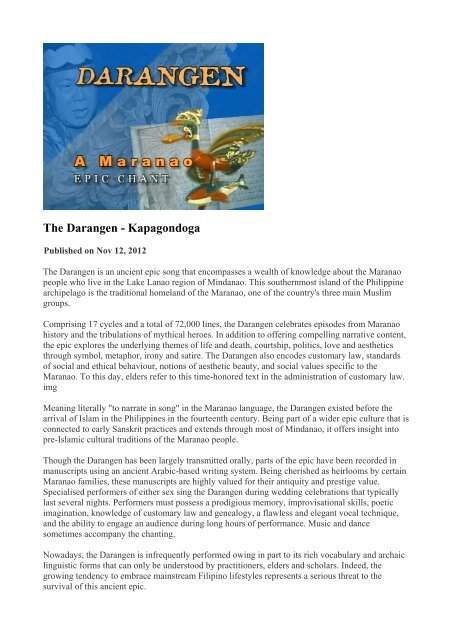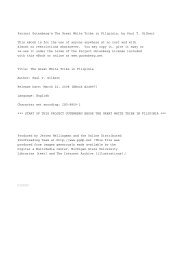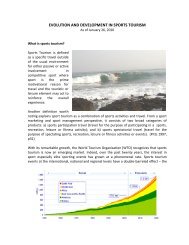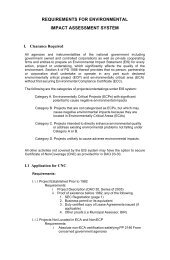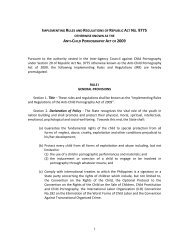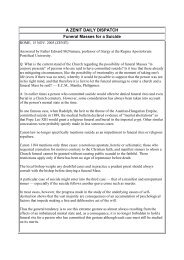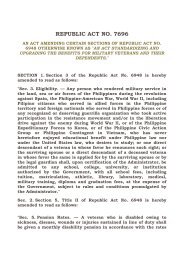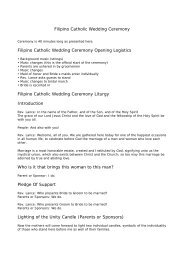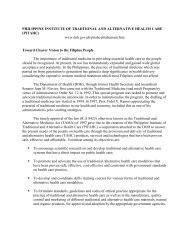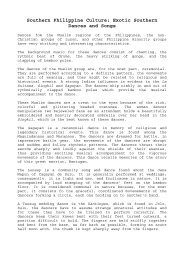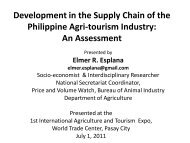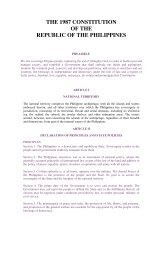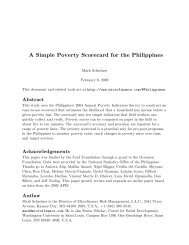The Darangen - Kapagondoga - Philippine Culture: Overview Culture
The Darangen - Kapagondoga - Philippine Culture: Overview Culture
The Darangen - Kapagondoga - Philippine Culture: Overview Culture
Create successful ePaper yourself
Turn your PDF publications into a flip-book with our unique Google optimized e-Paper software.
<strong>The</strong> <strong>Darangen</strong> - <strong>Kapagondoga</strong><br />
Published on Nov 12, 2012<br />
<strong>The</strong> <strong>Darangen</strong> is an ancient epic song that encompasses a wealth of knowledge about the Maranao<br />
people who live in the Lake Lanao region of Mindanao. This southernmost island of the <strong>Philippine</strong><br />
archipelago is the traditional homeland of the Maranao, one of the country's three main Muslim<br />
groups.<br />
Comprising 17 cycles and a total of 72,000 lines, the <strong>Darangen</strong> celebrates episodes from Maranao<br />
history and the tribulations of mythical heroes. In addition to offering compelling narrative content,<br />
the epic explores the underlying themes of life and death, courtship, politics, love and aesthetics<br />
through symbol, metaphor, irony and satire. <strong>The</strong> <strong>Darangen</strong> also encodes customary law, standards<br />
of social and ethical behaviour, notions of aesthetic beauty, and social values specific to the<br />
Maranao. To this day, elders refer to this time-honored text in the administration of customary law.<br />
img<br />
Meaning literally "to narrate in song" in the Maranao language, the <strong>Darangen</strong> existed before the<br />
arrival of Islam in the <strong>Philippine</strong>s in the fourteenth century. Being part of a wider epic culture that is<br />
connected to early Sanskrit practices and extends through most of Mindanao, it offers insight into<br />
pre-Islamic cultural traditions of the Maranao people.<br />
Though the <strong>Darangen</strong> has been largely transmitted orally, parts of the epic have been recorded in<br />
manuscripts using an ancient Arabic-based writing system. Being cherished as heirlooms by certain<br />
Maranao families, these manuscripts are highly valued for their antiquity and prestige value.<br />
Specialised performers of either sex sing the <strong>Darangen</strong> during wedding celebrations that typically<br />
last several nights. Performers must possess a prodigious memory, improvisational skills, poetic<br />
imagination, knowledge of customary law and genealogy, a flawless and elegant vocal technique,<br />
and the ability to engage an audience during long hours of performance. Music and dance<br />
sometimes accompany the chanting.<br />
Nowadays, the <strong>Darangen</strong> is infrequently performed owing in part to its rich vocabulary and archaic<br />
linguistic forms that can only be understood by practitioners, elders and scholars. Indeed, the<br />
growing tendency to embrace mainstream Filipino lifestyles represents a serious threat to the<br />
survival of this ancient epic.
<strong>The</strong> Maranao epic, the <strong>Darangen</strong><br />
Published on Nov 7, 2012<br />
<strong>The</strong> darangen is an epic chant associated with the Maranao people, with the core area of habitation<br />
being the province of Lanao del Sur in the island of Mindanao. Although other variations exist<br />
among the Maranao ethnic communities living in other areas, among the Maguindanao ethnic<br />
group, and Manobo groups to the Pacific Coast. <strong>The</strong> one in Lanao del Sur is considered the most<br />
definitive.<br />
It is a pre-Islamic form of primarily oral literature, presently existing in an Islamic context.<br />
Implications contained in the epic point to influences reaching as far west as India. <strong>The</strong> epic is the<br />
culmination of all these influences and the core culture of the Maranao.<br />
On November 25, 2005 the Maranao epic chant, the <strong>Darangen</strong>, was also proclaimed as another<br />
<strong>Philippine</strong> masterpiece of oral and intangible heritage of humanity.<br />
UNESCO defines oral and intangible heritage as: "<strong>The</strong> totality of tradition-based creations of a<br />
cultural community, expressed by a group of individuals and recognized as reflecting the<br />
expectations of a community in so far as they reflect its cultural and social identity; its standards<br />
and values are transmitted orally, by imitation or by other means.


